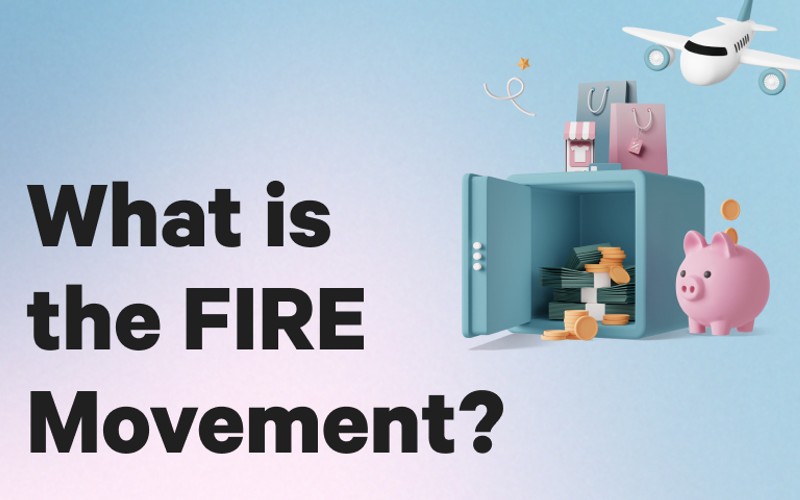The traditional way of thinking goes: get an education, get a job, save and invest a small portion of your money throughout your working years, and when you hit retirement at age 65, you’ll have a nest egg to live on. Then you can enjoy the fruits of your hard work.
But what if you didn’t want to wait that long?
The FIRE movement, which stands for Financial Independence, Retire Early, aims to help people reach financial freedom in their 30s, not their golden years. Here’s the rundown.
What is the FIRE movement?
The FIRE movement came into being through the 1992 bestselling book Your Money or Your Life. While the book outlined FIRE concepts and taught people how to reach financial independence, it didn’t mention the acronym.
While the traditional retirement age is assumed to be in a person’s 60s or 70s, FIRE sets the goalpost of ditching the full-time gig in a person’s 30s, 40s, or 50s. To do so, followers have extreme saving and investment goals — at least 50% of their income, and often more.
Who is FIRE for?
While it’s an admirable goal, and the principles appeal to most people, FIRE requires extreme saving levels that may not be right for you or may not work at this stage in your life.
If you plan to pursue FIRE, you’ll need to cut your costs substantially, increase your income, or, ideally, both. To achieve the 50-70% savings rate, you may have to pare your monthly expenses right down to the bone, at least initially. This can be incredibly challenging if you have children, live in an expensive urban area, or face an unexpected medical emergency or chronic health problem.
That said, only some people in the FIRE community go into it with the goal of early retirement.
Types of FIRE
FIRE has three main variations based on a person’s financial goals and spending habits. These approaches include:
Lean FIRE
Lean FIRE is for people who live minimalist lives now and plan to continue living minimalist lives in the future. The primary tenant is frugality and cutting back on expenses substantially to save money quickly.
Fat FIRE
The Fat FIRE lifestyle is the opposite of Lean FIRE, with followers wanting to live lives of luxury (or at least comfort), both now and in the future. This typically takes both a high income and substantial savings. Since followers of Fat FIRE do not want to limit how much they can spend, they need to earn enough to pay for their lifestyle now and invest for a continued standard of living in the future.
Barista FIRE
The goal of people who pursue Barista FIRE is not full retirement but the ability to cut down on their work hours. This is for risk-averse people who want to continue holding down a job for health benefits or continued income. By putting away money for the future, they hope to work part-time or do gig work that allows them the flexibility they need without needing to retire fully.
Calculating your FIRE number
You’ll first need to calculate your unique FIRE number, the amount of money you need to save to hit your retirement goals. This varies widely based on your income, current savings amount, and savings rate, but most FIRE proponents use the 4% rule to arrive at this number.
The 4% rule is a personal finance guideline for how much you should withdraw from your investment portfolio each year. The rule says that at a 4% annual withdrawal rate from your retirement savings, you can live on the investments for 30 years.
To achieve FIRE, therefore, you use the 25x rule. You’ll need to invest 25 times your annual expenses to hit your retirement goal.
To arrive at your FIRE number, multiply your living expenses by 25. That’s the number you should invest to have enough money to retire comfortably.
The FIRE roadmap
To achieve their goals, FIRE adherents go back to the basics: save more, spend less. These strategies can speed up the process:
1. Cut your expenses
While some followers practice aggressive saving, others take a more moderate approach. The fact is, the lower your expenses, the easier it is to achieve FIRE. Not only because you’re spending less money now, but if you keep up that frugal lifestyle into retirement, you’ll need much less money to maintain it.
To start with this step, look through bank and credit card statements to see where to make some cuts. FIRE followers avoid luxury items and large purchases unless necessary. You can use online budgeting tools to help you get — and stay — on track. This is also a good time to put together a starter emergency fund to meet any unexpected expenses.
2. Increase your income
In addition to saving, bringing in extra money can help you move much faster toward your goal. Ways to earn extra cash include:
- Working overtime
- Getting a part-time job
- Taking on freelancing or consultancy work
- Starting a side hustle
- Moving on to a better-paying job
- Monetizing your social media content
- Starting a dropshipping business
- Creating passive income through digital products
- Writing and self-publishing books
- Offering coaching services
3. Pay off debt
In the FIRE methodology, there is no debt. Debt not only adds to your current expenses but the interest you’re paying could be put towards savings. As a first step, consider paying off debt, especially high-interest credit card debt. Any student, personal, and auto loans should need paying off, too.
4. Prioritize saving and investing
Saving and investing form the backbone of everything you’ll do in your pursuit of FIRE. At a minimum, you’ll want to put aside 25% of your income. To speed up the process, you’ll want to get to a 50% savings rate as soon as possible. And if you want to go full FIRE and can afford it given your lifestyle and responsibilities, you could go as high as 70%.
Look into investment strategies that give you the maximum growth for your money. While savings accounts are low-risk, they don’t often keep up with the inflation rate and may not match the rising cost of living. Instead, look into retirement accounts such as Roth IRAs, self-directed IRAs, and 401(k)s, as well as the stock market, to grow your money. Consider speaking with a financial advisor before making any financial decisions.
The bottom line
While the FIRE movement has been around for several decades, it caught additional momentum during the Covid-19 pandemic, when Americans started questioning their priorities. The FIRE methodology can be an excellent way to kickstart your retirement plans and quickly build a future for yourself and your family. Regardless of whether you pursue it, the key takeaways of the movement offer some solid financial advice that could serve your financial future.
If you’re looking for an investment vehicle that will grow your money in the long term while also giving you short-term cash flow, Arrived can help. At Arrived, our mission is to provide financial freedom for everybody through accessible real estate investments.
The opinions expressed in this article are for general informational purposes only and are not intended to provide specific advice or recommendations for any individual or on any specific security or investment product. The views reflected in the commentary are subject to change at any time without notice. View Arrived’s disclaimers.








